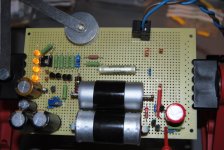So I am thinking if centering at 12.5mA IDSS then the Rs will be bit higher but not too high for the same gain and able to bring +/- 0.5mA samples together with the degeneration it will provide. Then again when having so many around 11mA they should be the preferred ones not to be adding extra noise from Rs. It would not be an issue if it was not for maintaining some currents in value and proportion so to center it easily always.
You can suggest Rs for different groups, i.e. 10.5; 11; 11.5; 12 and 12.5
With the 3.01 ohm resistors I've already bought, which pairs can I use for 2x 2SK369 63dB version? 10.5 > 11.5 ?
With the 3.01 ohm resistors I've already bought, which pairs can I use for 2x 2SK369 63dB version? 10.5 > 11.5 ?
Last edited:
Most probably will do so. Good thing is that in Tea-Bag's and yours there is an even spread they are not bunched only low or mid or high.
With the 3.01 ohm resistors I've already bought, which pairs can I use for 2x 2SK369 63dB version? 10.5 > 11.5 ?
Your 11.21, 11.21, 11.22, 11.22
P.S. Another way is to measure their resistance from drain to source. If you will do a check you will notice that same IDSS pairs show the same RDS. The higher the IDSS the lower the RDS also.
i found this :
JFET Matcher
Self explanatory. DMM in Ohm mode and you measure across drain to source.
After measuring my last batch of k170, I found some deviations of Vp even in matched Idss pairs.
I know that we should match for Idss and Vp in order to get the same gain figures.
According to the formula Rds = Vp / (2 x Idss) found in those papers, a 7.55 Idss fet with 0619 Vp should have Rds = 41
I just measured the same specimen with a DMM and got Rds = 39.9 ohm
Admitting the deviations are not significative, I would say we could match those fets for same Idss and Rds using a DMM. 🙂
Exactly why I mentioned. Biggest deviation in average DMM should come from its mA spec and it mixes along your calc. So your RDS is valid.
Yes, those are almost perfect, but I do need another quad for a friend.
Choose next best around the 11 mark.
I can get both bf245 b and c, but a seems harder.
Off topic, but why is always the semiconductors I´m looking for out of stock? Is it the universe, or is this a hipster thing audio designers do?
Off topic, but why is always the semiconductors I´m looking for out of stock? Is it the universe, or is this a hipster thing audio designers do?
I can get both bf245 b and c, but a seems harder.
Off topic, but why is always the semiconductors I´m looking for out of stock? Is it the universe, or is this a hipster thing audio designers do?
I beleive we can use 2SK170 here as well. Salas will confirm though.
Agreed - these are not generally available now.
Not of major importance, but use a K117GR left off from some SSLV1.1, or degenerate a BF245B down to 5mA instead of a K170. BF245A are plenty here BTW.
Found one in a Pitagyros last year 😀BF245A are plenty here BTW.
Found one in a Pitagyros last year 😀
Yes, it biases the tzatziki.
Plenty of reasons to come back to Greece.
Haha. I got five on ebay from some colder islands. Britain. They were cheap in piles from hong kong, but I guess they will arrive quicker from within europe. Are these really only available from islands? People are not kidding when they say you can learn stuff from diy audio.
Another one up and running.
4 x k170 input fets
K72-6 Teflon 15n caps
K71-4 Polystyrene 47n caps
Full on second stage buffer (with fet ccs)
Now listening with a DL160.... no clipping... super silent... dynamic... Tone seems correct, must let it settle for a while, then retrim voltages and serious listenning ahead.
4 x k170 input fets
K72-6 Teflon 15n caps
K71-4 Polystyrene 47n caps
Full on second stage buffer (with fet ccs)
Now listening with a DL160.... no clipping... super silent... dynamic... Tone seems correct, must let it settle for a while, then retrim voltages and serious listenning ahead.
Attachments
First channel worked right away.... the second one was build during rush hour so I was not able to set correct voltages on 1st stage.... I had .3v offset in the input and too much current on the fets (150mV Vdrop on the Rs).... I decided to remove the fets and place one at the time so I could track the culprit..... One bad fet I found (maybe due to too much heat).
After that, I had to cover the four trannies with a special "enclosure" so they should share the same heat... now music 🙂
After that, I had to cover the four trannies with a special "enclosure" so they should share the same heat... now music 🙂
- Home
- Source & Line
- Analogue Source
- Simplistic NJFET RIAA
